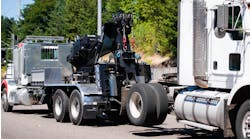As this issue went to press, several key changes to the hours-of-service rules for commercial drivers were slated to go into effect in less than two weeks.
The only way the new rules could have been delayed beyond July 1 would have been by a decision handed down by the U.S. Court of Appeals for the District of Columbia Circuit on a legal challenge brought by trucking stakeholders.
Even if the rule changes had been put off by a judgment—or if the court ordered them held in abeyance by ruling on the suit after the implementation date—the resulting delay would likely only last three months, as that is what the plaintiffs had sought.
Either way, savvy fleet owners would have been prepared for the new rules by late June. At least, that would be a wiser course than hoping for a fairly short court-ordered delay of the inevitable.
What’s also inevitable is that the battle over what the HOS rule should ultimately accomplish will continue, whether through public pressure on the Federal Motor Carrier Safety Administration (FMCSA) and the Congressional committees responsible for its oversight, or through further lawsuits.
Consider that in testimony before the House Subcommittee on Highways & Transit in mid-June, highway-safety activist Joan Claybrook, consumer co-chair of the nonprofit Advocates for Highway & Auto Safety and a former Administrator of the National Highway Traffic Safety Administration, declared that the latest HOS rule still does not fully address the issue of driver fatigue.
Claybrook argued that further changes to the rule will be needed to more fully address driver fatigue. “Despite back-to-back judicial decisions overturning the rule in each case, FMCSA refused to make changes to the maximum daily and weekly driving and work-hours allowed by the current HOS rule,” she said.
She went on to stress that “numerous research studies and scientific findings…conclude that there is an increased risk of crashes associated with more driving and working hours among commercial drivers,” and then made her case with these points:
- Crash risk increases geometrically after the eighth consecutive hour of driving.
- Under the current HOS rule, drivers are not getting sufficient sleep, obtaining, on average, less than six hours of sleep on work nights.
- Because humans have a biological diurnal schedule that normally requires nighttime sleep, attempts to sleep during daytime result in shorter and less restful sleep periods as compared to nighttime sleep.
- Lack of sufficient sleep from day-to-day and week-to-week results in cumulative sleep deprivation, or sleep debt, that can only be overcome through extended periods of off-duty time for rest and recovery.
“Despite unfounded assertions that the current HOS rule is working well and contributing to safety, fatigue is still a major problem that drivers readily acknowledge,” Claybrook added. “Studies have found that a substantial percentage of truck drivers admit to high levels of fatigued driving and actually falling asleep behind the wheel.”
In his opening statement at the hearing committee, chairman Rep. Thomas E. Petri (R-WI) rightly pointed out that every stakeholder impacted by HOS has “passionate beliefs on the correct way to implement them, so it’s no wonder that litigation has persisted.” And may well persist for some time to come.
At the same hearing, a different alarm about the HOS rule changes was sounded by an agent of law enforcement. Testifying in his role as president of the Commercial Motor Vehicle Safety Alliance, Major Mark Savage of the Colorado State Patrol stated that the pending hours of service changes “will continue to make enforcement more difficult, especially for those drivers and carriers who choose not to comply… The rules have shortened the work period for some drivers, thus increasing the temptation to falsify their records of duty status.”
Savage then argued what seems a valid point that “without additional tools in the toolbox, such as electronic logging devices and supporting document requirements to be maintained on the vehicle, roadside enforcement’s job will continue to be challenging and those who seek to break the rules will have more opportunities to do so.”


